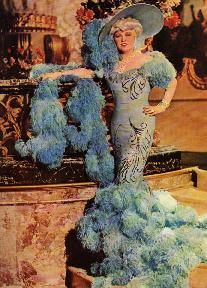If you’ll recall, just before I elected to ski down the slippery slope of dissecting all of the problems Hollywood narration can bestow upon a manuscript, I was already perched upon a soapbox, pointing out the pacing, voice, and storytelling dangers inherent to sneaking too much background information or physical description into interview scenes early in a novel submission.
Today, I’m clambering back up on that soapbox. Because, honestly, I’m reading as fast as I can, but I’m just not going to be able to read every manuscript in the English language before it lands upon the always-crowded desk of our old pal, Millicent the agency screener.
No doubt spilling her too-hot latte.
For those of you who missed my earlier posts on the subject, an interview scene is one where a character — generally the protagonist — obtains information critical to the plot and/or character development from another character, extracted through dialogue.
And a questionable interview scene is one in which, as is all too often the case in submissions, the narrator is not a particularly good interviewer, causing the reader to become impatient and/or lose interest in following that person who NEVER ASKS THE LOGICAL FOLLOW-UP QUESTION or JUST SITS THERE WITHOUT ASKING ANYTHING, waiting for the interview subject to spill his guts spontaneously.
If the reader in question happens to be Millicent, her cousin Maury the editorial assistant, or her Aunt Mehitabel the noted contest judge (hey, they’re a literary-minded family), the consequences are usually even more serious: if she loses interest in the manuscript before her, she tends to stop reading.
In other words, “Next!”
How may a writer avoid this grisly fate? Here’s a good rule of thumb: while not everything that people say in real life makes good dialogue, it’s an excellent idea to make sure that all of your dialogue is in fact something a real person MIGHT say.
And here’s a secondary rule of thumb — a rule of forefinger, one might say: that goes double for any dialogue that sounds anything remotely like Hollywood narration.
Yes, even if you have heard with your own tiny, shell-like ears a real person speak that way. As I have been pointing out none too gently for the past couple of days, real human beings tend not to tell one another things they already know — except, of course, about the weather (“Some heavy rains we’ve been having, eh?”), the relative progress sports teams (“How about them Red Sox?”), and politics (I’m not even going to go there until the Democratic nomination is beyond dispute).
In print, such iterations of mundane issues are notably primarily for their soporific value. As storytelling, such homely gems just tend to slow down the action of the scene.
Interestingly enough, adhering to these two rules while revising almost always results in trimming interview scenes substantially. This is particularly true for interviews that open novels, where Hollywood narration and dialogue stuffed with visual clues about characters tend to congregate — and thus are likely to do the most damage.
I sense some shifting in seats out there. “Yeah, yeah,” the impatient are murmuring. “You already yammered at us about this, Anne. Cut to the chase, already.”
Funny, that last sentence is precisely what Millicent is often heard muttering over interview scenes.
But you have a legitimate point, impatient mutterers. However, in my discussions earlier in the week, I left out one of the primary reasons Millicent tends to have that particular knee-jerk reaction: if the first couple of pages of text are a bit heavy-handed, agency screeners, contest judges, and other professional readers usually leap to the conclusion that the ENTIRE text reads the same way.
An assumption, as you no doubt have already guessed, that conveniently enables Millie and her ilk to reject the descriptively front-loaded submission immediately and move swiftly on to the next.
I have seen a LOT of good manuscripts done in by this tendency. Because this is such a common problem, as an editor, one of the first places I look to trim is that first scene — which, as I mentioned a few days back, is very, very frequently an interview scene.
Particularly if the opening scene relies far more heavily upon dialogue than narration. Take, for instance, this piece of purple-tinted prose:
“Don’t you go rolling those large hazel eyes at me, Thelma,” Marcel warned. “It hasn’t worked on me since our days in the chorus twelve years ago, in that bizarre road company of Auntie Mame. And you can save the eyelash fluttering, too. You’re wearing too much mascara, anyway.”
Thelma laughed. “That’s a fine criticism, coming from a man wearing false eyelashes. Just because you’re a drag queen doesn’t mean you can’t dress with some taste. I mean, bright red lipstick with a pale lavender sweater? Please.”
“What about you?” Marcel shot back. “In your puce bathrobe with purple magnolias dotted all over it still, at this time of day!”
Thelma walked around him, to check that the seams on his stockings were straight. “Because you’re my best friend in the world, I’m going to be absolutely honest with you: you’re too heavy-set for a miniskirt now, darling. Certainly if you’re not going to shave your legs. What are you now, forty-five and a size twenty-four?”
Marcel smoothed down his Technicolor orange wig. “At least at six feet, I’m tall enough to wear Armani with style. Your cramped five foot three wouldn’t even be visible on a catwalk.”
Admittedly, the banter here is kind of fun, but a judicious mixture of dialogue and narration would convey the necessary information less clumsily, without rendering the dialogue implausible. Try this moderately snipped version on for size:
Thelma rolled her large hazel eyes. Even ensconced in a ratty puce bathrobe that barely covered her short, round form, she carried herself like the Queen of the Nile.
Unfortunately for her dignity, her icy hauteur act had grown old for Marcel twelve years ago, three weeks into their joint chorus gig in that chronically under-attended road tour of Auntie Mame. “You can save the eyelash fluttering, sweetheart. You’re wearing too much mascara, anyway.”
Thelma laughed. “You’re a fine one to talk taste. Bright red lipstick with a pale lavender sweater? Please.”
His thick, black false eyelashes hit where his pre-plucked eyebrow had originally been; his current fanciful impression of an eyebrow swooped a good four inches higher, threatening to merge with his Technicolor orange wig. Even for a career drag queen, his moue of surprise was a bit overdone. “Will you be getting dressed today, darling?” he asked brightly. “Or should I just get you another bottle of gin, to complete your Tallulah Bankhead impression?”
Thelma walked around him, to check that the seams on his stockings were straight. He was getting too heavy to wear fishnets every night; still, not bad gams, for a forty-five-year-old. “If you insist upon wearing a miniskirt, my sweet, you might want to consider shaving your legs.”
Same information, but more naturally presented, right? By having the narration take over the bulk of the descriptive burden, a rather amusing narrative voice has emerged, conveying a point of view distinct from either Marcel or Thelma’s.
I can hear my mutterers muttering again. “Okay, so the second version has a stronger narrative voice,” they concede. “But even so, all of that physical description makes the scene drag a bit, doesn’t it?”
Which brings me back to my closing question from yesterday: other than the fact that television and movies have accustomed us all to having an instantaneous picture in our heads of a story’s protagonist, is there a valid reason that a narrative must include a photographic-level description of a character the instant s/he appears in the book?
Anytime you sit down to ponder revising the first few pages of a novel, it’s worth investing a moment or two in pondering the possibility that there is no such reason.
Consider it, perhaps, while sitting with a hard copy of your first few pages in your hand. Is there backstory or physical description that could come more gradually, later in the chapter or even later in the book?
Or — and this is a possibility that often occurs to professional readers of interview scenes, let me tell you — is that Hollywood narration or description-laced dialogue the book’s way of telling us that perhaps the book opens at the wrong part of the story?
I hope that didn’t make anyone out there faint; I’m not the kind of doctor that can resuscitate the fallen with impunity.
But I am the kind that can suggest ways to improve your book. Might, for instance, we learn more about Thelma and Marcel in a more graceful manner if, instead of beginning the novel with the dialogue above, it opened with a short prologue showing them twelve years ago, bright-eyed, innocent, and slim — and then jumped ahead to this scene, to show how they and their relationship have changed?
Dramatic, eh? One might even say character-revealing.
Of course, front-loading an opening scene with physical description is not necessarily an indicator of a structural problem. I suspect that often, writers who use this technique as a means of introducing description are driven primarily by a panicked sense that the reader must be told what the characters look like the instant they appear in the text — combined with a recollection that their high school writing teachers said that too-extensive physical descriptions in the narrative are dull. So they’re sort of trying to, you know, sneak the physical description in when the reader isn’t looking.
Trust me, a professional reader is ALWAYS looking. It’s her job.
Looking specifically, in the case of an agency screener or editorial assistant plugging through a mountain of submissions, for a reason to reject the manuscript in front of her. By avoiding the common twin traps of overloading the first scene with crammed-in backstory and physical description, a manuscript stands a much greater chance of cajoling Millicent into reading on to scene #2.
And we all want that, don’t we?
I sense more impatient shifting in the peanut gallery. “Um, Anne?” these fed-up folks say. “Isn’t this the same point you made a few days ago? I get it, already: don’t use dialogue to have characters describe one another. Have you considered that there might not be a reason to keep telling us this?”
Ah, but you’re assuming that I’ve already made my primary point. Far from it; like other doctors, we book medicos bill for our advice by the hour.
So here comes some professional wisdom: after a screener has had the privilege of scanning a thousand manuscripts or so, it becomes pretty clear that many aspiring writers don’t really understand what the writing gurus mean when they urge us all to open with a hook.
A hook, for those of you new to the term, is a grabber located within the first paragraph of a story or book — preferably within the first sentence, according to some writing teachers — that so intrigues the reader that s/he is instantly sucked into the story. (This is not to be confused with a Hollywood hook, a one- or two-sentence pitch for a script or book. See the so-named category on the list at right, if you are curious about the latter.)
Often, aspiring writers will interpret the advice to open with a hook to mean that a storyline must open with violent or even bloody action, a mystery that the reader will want to solve, or a conflict-ridden scene. While admittedly Millicent sees a whole lot of manuscripts that open with a bang (with or without gushes of blood), all of these strategic choices can indeed work, if handled well.
Although let me tell you, they are such common choices that it’s a downright relief to most professional readers when a writer elects to open with a powerful visual or sensual image instead.
What’s even more common than the book that kicks off with conflict? An beginning that insists that the reader must be 100% up to speed on the plot and characters by the bottom of page 1 — or page 5 at the latest.
Again, that vexing question rears its ugly head: is this strictly necessary?
Brace yourselves, because I’m about to suggest a revision technique that may shock some of you: just as an experiment, try removing the first scene of your book. Not permanently, mind you — and certainly not without having made a backup copy of the original first, in case you decide after mature and careful consideration that this was a stupid idea.
Cut it just long enough to find out whether the story would make sense to the reader without it. If it can fly that way, consider cutting the scene entirely and starting fresh slightly later in the plot.
I’m quite serious about this — you wouldn’t believe how many good manuscripts don’t actually begin until a couple of scenes in, or that allow absolutely gorgeous opening sentences or images to languish on page 4. Or page 15.
Or the beginning of Chapter Three.
Yes, I know: what I’m suggesting is potentially pretty painful; as we discussed in the GETTING GOOD AT ACCEPTING FEEDBACK series (still conveniently accessible in the category list at right, in case you missed it), many, many aspiring writers regard the approach of the reviser’s pen with every bit of the fear and loathing that the published writer feels for governmental censorship. But it’s just a fact that when we’re first constructing a narrative, we writers are not always right about where the story should begin and end.
If you don’t believe this, I can only suggest that you take a gander at THE BROTHERS KARAMAZOV, an undoubted masterpiece that could have lost most of the first 200 pages without bugging the reader much at all.
(That’s a professional opinion, by the way. One of the great fringe benefits of having walls lined with diplomas from prestigious institutions and a Ph.D. that’s just gathering dust these days is the ability make sweeping judgments like that about classics without fear of sounding ignorant. While I’m at it, allow me to add: THE TAMING OF THE SHREW is a stupid play, and I found A TALE OF TWO CITIES far-fetched. So there.)
Try to keep an open mind while you’re revising. Be willing to consider the possibility that your story might be more effective — and hook the reader better — if you began it at a different point. Or at least do a little field testing to rule it out.
Believe me, you’ll sleep better at night if you do.
How do I know this, you ask? Because now, I’ve planted the doubt in your mind. As much as you might pooh-pooh the idea that all or part of your opening could be snipped away without fundamental harm to the storyline, can you be ABSOLUTELY sure that it’s a stupid suggestion without going back over it pretty rigorously.
You’re welcome — and I mean that very seriously, because an aspiring writer who is willing to examine and reexamine her writing before she submits it is going to have a much, much easier time coping with editorial feedback later on in the process.
Trust me; I’m a doctor. That diploma over there says so.
Keep up the good work!




